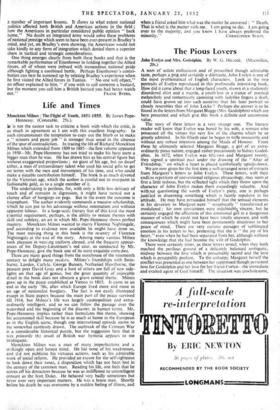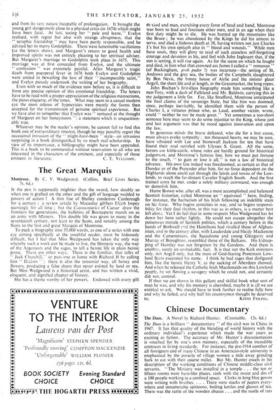The Pious Lovers
A &IAN of sedate enthusiasm and of prescribed though admirable taste, perhaps a prig and certainly a dilettante, John Evelyn is one of the most problematical of English characters. Look at the two portraits of Evelyn reproduced in this profoundly interesting book, How did it come about that a long-faced youth, shown in a studiously disordered shirt and a mantle, a youth lost in a trance of poetical melancholy and romantically caressing with ladylike fingers a skull, could have grown up into such austerity that his later portrait so closely resembles that of John Locke ? Perhaps the answer is to be found in the letters from Margaret Blagge (Mrs. Godolphin) which are here presented and which give this book a definite and uncommon value.
The story of these letters is a very strange one. The literary reader will know that Evelyn was bored by his wife, a woman who possessed all the virtues but very few of the charms which he so greatly admired. In his fiftieth year he began to trifle innocently and without any robust intention-among the Maids of Honour. From these he ultimately selected Margaret Blagge, a girl of an extra- ordinarily pious nature, engaged rather precariously to Sidney Godol-
- phin. In 1672, when Evelyn was fifty-two and Margaret twenty, they signed a spiritual pact under the drawing of the "Altar of Friendship," on which a heart is placed symbolically upside-down.
We are now given for the first time a well-arranged series of extracts from Margaret's letters to John Evelyn. These letters, with their endless repetition of conventional religious phraseology, may seem at first a little tedious, but the reflected light which they throw upon the character of John Evelyn makes them exceedingly valuable. And without questioning the worth of Evelyn's piety, one is perhaps justified in discerning something which is faintly repulsive in his attitude. He may have persuaded himself that the sensual elements in his devotion to Margaret were " seraphically " transformed or modulated ; his own convictions were indubitably, sincere, but he certainly engaged the affections of this emotional girl in a dangerous manner of which he could not have been totally unaware, and with consequences which might have been permanently disastrous to her peace of mind. There are very curious passages of sublimated emotion in his letters to her, protesting that she is " the joy of his heart," even when he had been separated from her, although without the knowledge that she had become the wife of Godolphin.
There were certainly times, as these letters reveal, when they both reached the perilous ground of a delicately balanced ambiguity, midway between the love which is presumably sacred and the love which is perceptibly profane. To the unhappy Margaret herself the conflict was presented as one between her suppressed though persistent love for Godolphin and her love for her friend Evelyn—the immediate and exalted agent of God himself. The situation was unwholesome,
and from its very nature incapable of prolongation. It brought the young girl dangerously close to a physical crisis (in 1674) which might have been fatal. At last, seeing her " pale and leane," Evelyn realised, with regret but also with strange abruptness, that the " seraphic friendship " may have been partly responsible, and he advised her to marry Godolphin. There were lamentable vacillations as the letters show), and Margaret's return to good health and improved spirits was not entirely pleasing to her spiritual adviser. But Margaret's marriage to Godolphin took place in 1675. This Marriage was at first concealed from Evelyn, and the ultimate " confession " was extremely painful. After Margaret's tragic death from puerperal fever in 1678 both Evelyn and Godolphin were united in bewailing the loss of their " incomparable saint," and Evelyn piously undertook the writing of her biography. Even with so much of the evidence now before us, it is difficult to form any precise opinion of this emotional friendship. The letters have to be read with a proper appreciation of The religious mannerisms, the pious etiquette, of the times. What may seem to a casual modern eye the most odious of hypocrisies were merely the forms then accepted for the transmission of genuine spiritual experience. But we have also to remember that Evelyn was " tortured at the thought of Margaret on her honeymoon ": a statement which is unquestion- ably true.
Whatever may be the reader's opinion, he cannot fail to find this book one of extraordinary interest, though he may possibly regret the occasional intrusion of the " might-have-been " style—an intrusion surprising in a book distinguished by so much real scholarship. In view of its importance, a bibliography might have been appended. This is a book to be commended without reservation to all who are interested in the characters of the eminent, and especially of those



































 Previous page
Previous page